Study on Water Purification Effect and Operation Parameters of Various Units of Wastewater Circulation
Abstract
:1. Introduction
2. Materials and Methods
2.1. Experimental Design and Sampling
2.2. Water Quality Detection and Optimization
2.3. Influencing Factors with Different Loads, Hydraulic Residence Times (HRTs) and Ratios
2.4. Data Analysis
3. Results
3.1. Screening, Collocation, and Optimization of Secondary Unit Purification Materials
3.2. Influencing Factors of Different Loads, Hydraulic Residence Times, and Ratios
4. Discussion
5. Conclusions
Author Contributions
Funding
Institutional Review Board Statement
Informed Consent Statement
Data Availability Statement
Conflicts of Interest
References
- Bian, Z.; Cao, F.; Zhu, J.; Li, H. Plant uptake-assisted round-the-clock photocatalysis for complete purification of aquaculture wastewater using sunlight. Environ. Sci. Technol. 2015, 49, 2418–2424. [Google Scholar] [CrossRef] [PubMed]
- Bhuyar, P.; Farez, F.; Pragas Maniam, G.; Govindan, N. Removal of nitrogen and phosphorus from agro-industrial wastewater by using microalgae collected from coastal region of peninsular Malaysia. Afr. J. Biomed. Res. 2021, 3, 58–66. [Google Scholar] [CrossRef]
- Fei, X.; Sun, S.; He, S.; Huang, J.; Zhou, W. Application of a novel two-stage biofiltration system for simulated brackish aquaculture wastewater treatment. Environ. Sci. Pollut. Res. 2022, 27, 636–646. [Google Scholar] [CrossRef] [PubMed]
- Fisheries and Fisheries Administration Bureau. Ministry of Agriculture and Rural Affairs. 2021 China Fishery Statistics Yearbook; China Agriculture Press: Beijing, China, 2021; pp. 1–30. [Google Scholar]
- Ministry of Environmental Protection, Bureau of Statistics, Ministry of Agriculture. Communiqué of the Second National Survey of Pollution Sources; Ministry of Environmental Protection of the People’s Republic of China: Beijing, China, 2020; Volume 48, pp. 8–10. [Google Scholar]
- Deng, M.; Zhao, X.; Senbati, Y.; Song, K.; He, X. Nitrogen removal by heterotrophic nitrifying and aerobic denitrifying bacterium Pseudomonas sp. DM02: Removal performance, mechanism and immobilized application for real aquaculture wastewater treatment. Bioresour. Technol. 2021, 322, 124555. [Google Scholar] [CrossRef] [PubMed]
- Xiao, R.; Wei, Y.; An, D.; Li, D.; Ta, X.; Wu, Y.; Ren, Q. A review on the research status and development trend of equipment in water treatment processes of recirculating aquaculture systems. Rev. Aquac. 2019, 11, 863–895. [Google Scholar] [CrossRef]
- Yin, H.; Yan, X.; Gu, X. Evaluation of thermally-modified calcium-rich attapulgite as a low-cost substrate for rapid phosphorus removal in constructed wetlands. Water Res. 2017, 115, 329–338. [Google Scholar] [CrossRef]
- Yin, H.; Yang, P.; Kong, M.; Li, W. Preparation of the lanthanum-aluminum-amended attapulgite composite as a novel inactivation material to immobilize phosphorus in lake sediment. Environ. Sci. Technol. 2020, 54, 11602–11610. [Google Scholar] [CrossRef]
- Wang, Y.Q.; Zheng, Y.; Qian, X.Y.; Yang, X.X.; Chen, J.Z.; Wu, W. Selection of the purification material and its operating parameters for primary precipitation units. J. Agro Environ. Sci. 2020, 39, 2621–2630. [Google Scholar] [CrossRef]
- Sangnoi, Y.; Chankaew, S.; O-Thong, S. Indigenous Halomonas spp., the potential nitrifying bacteria for saline ammonium waste water treatment. Pak. J. Biol. Sci. 2017, 20, 52–58. [Google Scholar] [CrossRef] [Green Version]
- Kuebutornye, F.K.; Abarike, E.D.; Lu, Y. A review on the application of Bacillus as probiotics in aquaculture. Fish Shellfish Immunol. 2019, 87, 820–828. [Google Scholar] [CrossRef]
- Li, Y.; Wang, L.; Chao, C.; Yu, H.; Yu, D.; Liu, C. Submerged macrophytes successfully restored a subtropical aquacultural lake by controlling its internal phosphorus loading. Environ. Pollut. 2021, 268, 115949. [Google Scholar] [CrossRef] [PubMed]
- Yan, Z.; Wang, Q.; Li, Y.; Wu, L.; Wang, J.; Xing, B.; Yu, D.; Wang, L.; Liu, C. Combined effects of warming and nutrient enrichment on water properties, growth, reproductive strategies and nutrient stoichiometry of Potamogeton crispus. Environ. Exp. Bot. 2021, 190, 104572. [Google Scholar] [CrossRef]
- Xu, J.; Liu, J.; Hu, J.; Wang, H.; Sheng, L.; Dong, X.; Jiang, X. Nitrogen and phosphorus removal in simulated wastewater by two aquatic plants. Environ. Sci. Pollut. Res. 2021, 28, 63237–63249. [Google Scholar] [CrossRef] [PubMed]
- Tenzin, J.; Hirunpunth, R.; Satjarak, A.; Peerakietkhajorn, S. Bacteria associated with Echinodorus cordifolius and Lepironia articulata enhance nitrogen and phosphorus removal from wastewater. Bull. Environ. Contam. Toxicol. 2021, 106, 377–384. [Google Scholar] [CrossRef]
- Sarma, S.J.; Tay, J.H. Carbon, nitrogen and phosphorus removal mechanisms of aerobic granules. Crit. Rev. Biotechnol. 2018, 38, 1077–1088. [Google Scholar] [CrossRef]
- Bao, T.; Yu, Z.M.; Damtie, M.M.; Wu, K.; Jin, J.; Zhang, Y.; Wei, X.L.; Frost, R.L. Use of autoclaved aerated concrete particles for simultaneous removal of nitrogen and phosphorus as filter media from domestic wastewater. Environ. Technol. 2019, 41, 3032–3042. [Google Scholar] [CrossRef]
- Nandakumar, S.; Pipil, H.; Ray, S.; Haritash, A.K. Removal of phosphorous and nitrogen from wastewater in Brachiaria-based constructed wetland. Chemosphere 2019, 233, 216–222. [Google Scholar] [CrossRef]
- Ji, J.; Peng, Y.; Wang, B.; Li, X.; Zhang, Q. A novel SNPR process for advanced nitrogen and phosphorus removal from mainstream wastewater based on anammox, endogenous partial-denitrification and denitrifying dephosphatation. Water Res. 2020, 170, 115363. [Google Scholar] [CrossRef]
- Li, Y.; Wang, L.; Yan, Z.; Chao, C.; Yu, H.; Yu, D.; Liu, C. Effectiveness of dredging on internal phosphorus loading in a typical aquacultural lake. Sci. Total Environ. 2020, 744, 140883. [Google Scholar] [CrossRef]
- Chao, C.; Wang, L.; Li, Y.; Yan, Z.; Liu, H.; Yu, D.; Liu, C. Response of sediment and water microbial communities to submerged vegetations restoration in a shallow eutrophic lake. Sci. Total Environ. 2021, 801, 149701. [Google Scholar] [CrossRef]
- Shen, S.; Li, X.; Cheng, F.; Zha, X.; Lu, X. Recent developments of substrates for nitrogen and phosphorus removal in CWs treating municipal wastewater. Environ. Sci. Pollut. Res. 2020, 27, 29837–29855. [Google Scholar] [CrossRef] [PubMed]
- Han, W.; Mao, Y.; Wei, Y.; Shang, P.; Zhou, X. Bioremediation of aquaculture wastewater with algal-bacterial biofilm combined with the production of selenium rich biofertilizer. Water 2020, 12, 2071. [Google Scholar] [CrossRef]
- Hawrot-Paw, M.; Koniuszy, A.; Gałczyńska, M.; Zając, G.; Szyszlak-Bargłowicz, J. Production of microalgal biomass using aquaculture wastewater as growth medium. Water 2019, 12, 106. [Google Scholar] [CrossRef] [Green Version]
- Andreotti, V.; Solimeno, A.; Rossi, S.; Ficara, E.; Marazzi, F.; Mezzanotte, V.; García, J. Bioremediation of aquaculture wastewater with the microalgae Tetraselmis suecica: Semi-continuous experiments, simulation and photo-respirometric tests. Sci. Total Environ. 2020, 738, 139859. [Google Scholar] [CrossRef] [PubMed]
- Srimongkol, P.; Thongchul, N.; Phunpruch, S.; Karnchanatat, A. Ability of marine cyanobacterium Synechococcus sp. VDW to remove ammonium from brackish aquaculture wastewater. Agric. Water Manag. 2019, 212, 155–161. [Google Scholar] [CrossRef]
- Marinho-Soriano, E.; Nunes, S.O.; Carneiro, M.A.A.; Pereira, D.C. Nutrients’ removal from aquaculture wastewater using the macroalgae Gracilaria birdiae. Biomass Bioenerg. 2009, 33, 327–331. [Google Scholar] [CrossRef]
- Saengsawang, B.; Bhuyar, P.; Manmai, N.; Ponnusamy, V.K.; Ramaraj, R.; Unpaprom, Y. The optimization of oil extraction from macroalgae, Rhizoclonium sp. by chemical methods for efficient conversion into biodiesel. Fuel 2020, 274, 117841. [Google Scholar] [CrossRef]
- Bhuyar, P.; Trejo, M.; Dussadee, N.; Unpaprom, Y.; Ramaraj, R.; Whangchai, K. Microalgae cultivation in wastewater effluent from tilapia culture pond for enhanced bioethanol production. Water Sci. Technol. 2021, 84, 2686–2694. [Google Scholar] [CrossRef]
- Praveen, P.; Loh, K.C. Nitrogen and phosphorus removal from tertiary wastewater in an osmotic membrane photobioreactor. Bioresour. Technol. 2016, 206, 180–187. [Google Scholar] [CrossRef]
- Cheng, H.Y.; Long, J.X.; Liu, Z. Aquaculture wastewater treatment with immobilized microorganisms-aquatic plants strengthened purification system. IOP Conf. Ser. Environ. Earth Sci. IOP Publ. 2018, 192, 012061. [Google Scholar] [CrossRef]
- Shao, Y.; Zhong, H.; Wang, L.; Elbashier, M. Purification effect of the aquaculture wastewater and sediment by microbial nanospheres with different material ratios and dosing methods. Sustainability 2020, 12, 1462. [Google Scholar] [CrossRef] [Green Version]
- Zhao, Z.; Zhang, X.; Wang, Z.; Song, X.; Cheng, M.; Cheng, M.; Zhang, Y. Enhancing the pollutant removal performance and biological mechanisms by adding ferrous ions into aquaculture wastewater in constructed wetland. Bioresour. Technol. 2019, 293, 122003. [Google Scholar] [CrossRef]
- Bawiec, A. Efficiency of nitrogen and phosphorus compounds removal in hydroponic wastewater treatment plant. Environ. Technol. 2019, 40, 2062–2072. [Google Scholar] [CrossRef] [PubMed]
- Wang, L.S.; Li, X.; Li, Y.Y.; Zhang, M.Y.; Wu, J.S. Nitrogen and phosphorus removal in surface flow constructed wetland planted with Myriophyllum elatinoides treating swine wastewater in subtropical central china. Environ. Sci. 2021, 42, 1433–1442. [Google Scholar] [CrossRef]
- Mohd Nizam, N.U.; Mohd Hanafiah, M.; Mohd Noor, I.; Abd Karim, H.I. Efficiency of five selected aquatic plants in phytoremediation of aquaculture wastewater. Appl. Surf. Sci. 2020, 10, 2712. [Google Scholar] [CrossRef] [Green Version]
- Shen, M.; Yin, Z.; Xia, D.; Zhao, Q.; Kang, Y. Combination of heterotrophic nitrifying bacterium and duckweed (Lemna gibba L.) enhances ammonium nitrogen removal efficiency in aquaculture water via mutual growth promotion. J. Gen. Appl. Microbiol. 2019, 65, 151–160. [Google Scholar] [CrossRef] [Green Version]
- Sun, J.; Li, N.; Yang, P.; Zhang, Y.; Yuan, Y.; Lu, X.; Zhang, H. Simultaneous antibiotic degradation, nitrogen removal and power generation in a microalgae-bacteria powered biofuel cell designed for aquaculture wastewater treatment and energy recovery. Int. J. Hydrogen Energy 2020, 45, 10871–10881. [Google Scholar] [CrossRef]
- Su, F.; Li, Z.; Li, Y.; Xu, L.; Li, Y.; Li, S.; Chen, H.; Zhuang, P.; Wang, F. Removal of total nitrogen and phosphorus using single or combinations of aquatic plants. Int. J. Environ. Res. Public Health 2019, 16, 4663. [Google Scholar] [CrossRef] [Green Version]
- Deng, Y.L.; Ruan, Y.J.; Zhu, S.M.; Guo, X.S.; Han, Z.Y.; Ye, Z.Y.; Liu, G.; Shi, M.M. The impact of DO and salinity on microbial community in poly (butylene succinate) denitrification reactors for recirculating aquaculture system wastewater treatment. AMB Express 2017, 7, 1–11. [Google Scholar] [CrossRef] [Green Version]
- Gao, Y.; Guo, L.; Shao, M.; Hu, F.; Wang, G.; Zhao, Y.; Gao, M.; Jin, C.; She, Z. Heterotrophic denitrification strategy for marine recirculating aquaculture wastewater treatment using mariculture solid wastes fermentation liquid as carbon source: Optimization of COD/NO3−-N ratio and hydraulic retention time. Bioresour. Technol. 2020, 304, 122982. [Google Scholar] [CrossRef]
- Nicholaus, R.; Lukwambe, B.; Zhao, L.; Yang, W.; Zhu, J.; Zheng, Z. Bioturbation of blood clam Tegillarca granosa on benthic nutrient fluxes and microbial community in an aquaculture wastewater treatment system. Int. Biodeter. Biodegr. 2019, 142, 73–82. [Google Scholar] [CrossRef]
- Han, P.; Lu, Q.; Fan, L.; Zhou, W. A review on the use of microalgae for sustainable aquaculture. Appl. Surf. Sci. 2019, 9, 2377. [Google Scholar] [CrossRef] [Green Version]
- Sheik, A.G.; Seepana, M.M.; Ambati, S.R. Supervisory control configurations design for nitrogen and phosphorus removal in wastewater treatment plants. Water Environ. Res. 2021, 93, 1289–1302. [Google Scholar] [CrossRef]
- Deng, L.; Peng, Y.; Li, J.; Gao, R.; Li, W.; Du, R. Enhanced simultaneous nitrogen and phosphorus removal from low COD/TIN domestic wastewater through nitritation-denitritation coupling improved anammox process with an optimal Anaerobic/Oxic/Anoxic strategy. Bioresour. Technol. 2021, 322, 124526. [Google Scholar] [CrossRef] [PubMed]
- Yuan, C.; Wang, B.; Peng, Y.; Li, X.; Zhang, Q. Simultaneous enhanced biological phosphorus removal and semi-nitritation (EBPR-SN) followed by anammox process treating municipal wastewater at seasonal temperatures: From summer to winter. Sci. Total Environ. 2021, 757, 144048. [Google Scholar] [CrossRef] [PubMed]
- Liu, S.; Daigger, G.T.; Liu, B.; Zhao, W.; Liu, J. Enhanced performance of simultaneous carbon, nitrogen and phosphorus removal from municipal wastewater in an anaerobic-aerobic-anoxic sequencing batch reactor (AOA-SBR) system by alternating the cycle times. Bioresour. Technol. 2020, 301, 122750. [Google Scholar] [CrossRef] [PubMed]
- Tang, C.C.; Tian, Y.; Liang, H.; Zuo, W.; Wang, Z.W.; Zhang, J.; He, Z.W. Enhanced nitrogen and phosphorus removal from domestic wastewater via algae-assisted sequencing batch biofilm reactor. Bioresour. Technol. 2018, 250, 185–190. [Google Scholar] [CrossRef] [PubMed]
- Le, T.H.X.; Mosley, L.; Marschner, P. Nitrogen and phosphorus removal from wastewater by sand with wheat straw. Environ. Sci. Pollut. Res. 2019, 26, 11212–11223. [Google Scholar] [CrossRef]
- Xin, X.; Yang, H.; Guan, L.; Liu, S.; Liu, J. Responses of nitrogen and phosphorus removal performance and microbial community to Fe3O4@SiO2 nanoparticles in a sequencing batch reactor. Appl. Biochem. Biotechnol. 2021, 193, 544–559. [Google Scholar] [CrossRef]
- Chakraborty, T.; Gabriel, M.; Amiri, A.S.; Santoro, D.; Walton, J.; Smith, S.; Ray, M.B.; Nakhla, G. Carbon and phosphorus removal from primary municipal wastewater using recovered aluminum. Environ. Sci. Technol. 2017, 51, 12302–12309. [Google Scholar] [CrossRef]
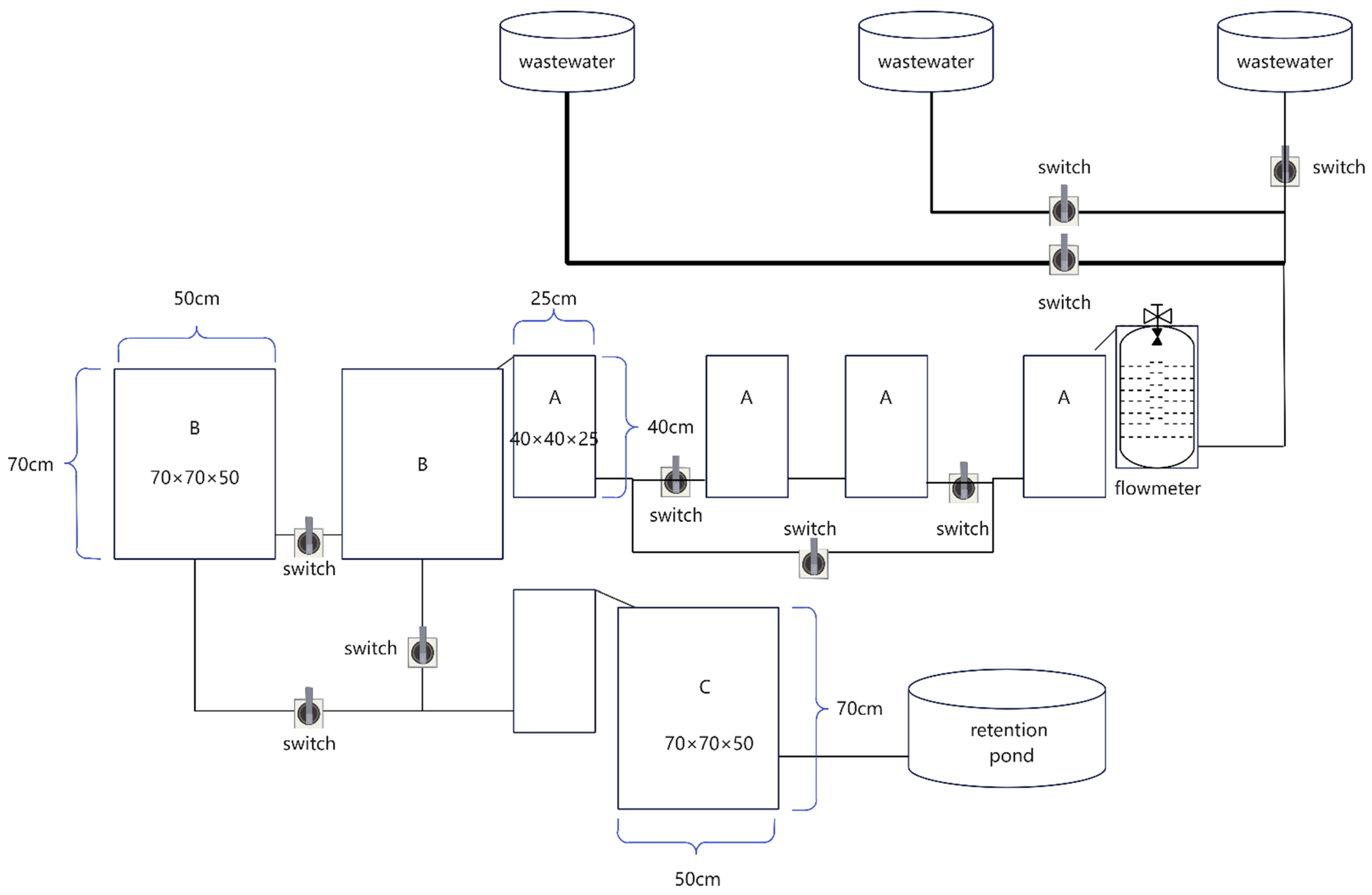
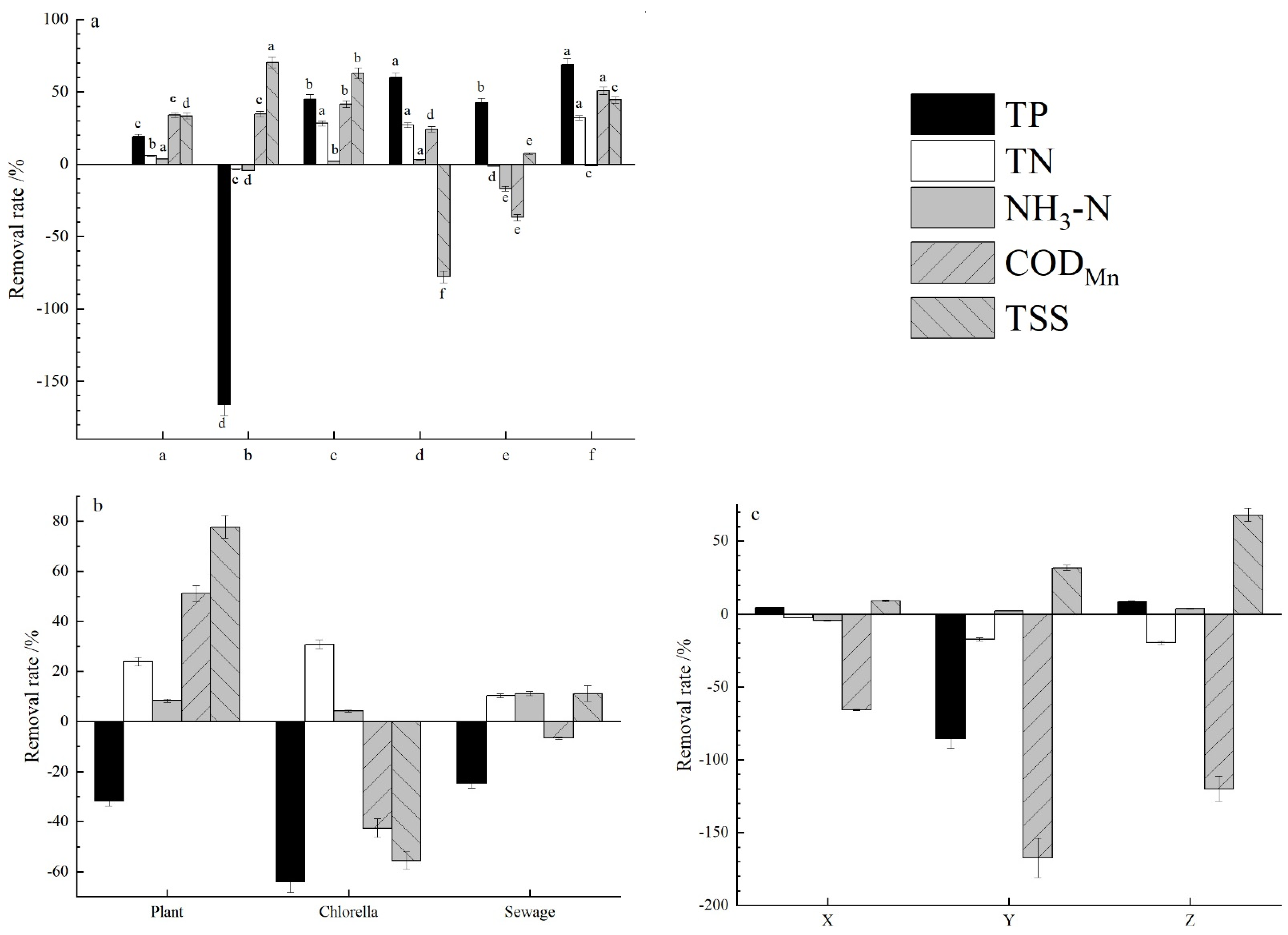
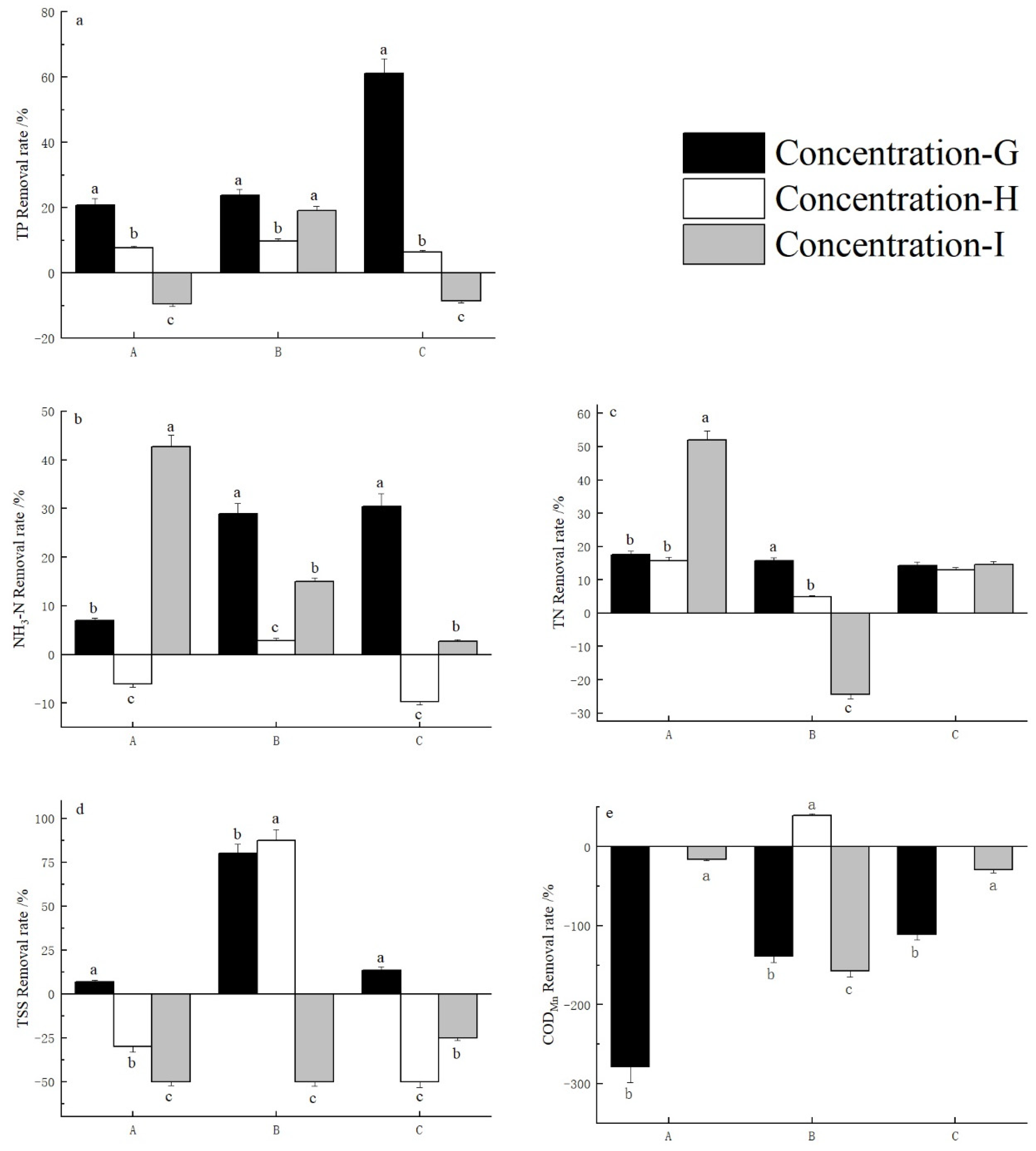
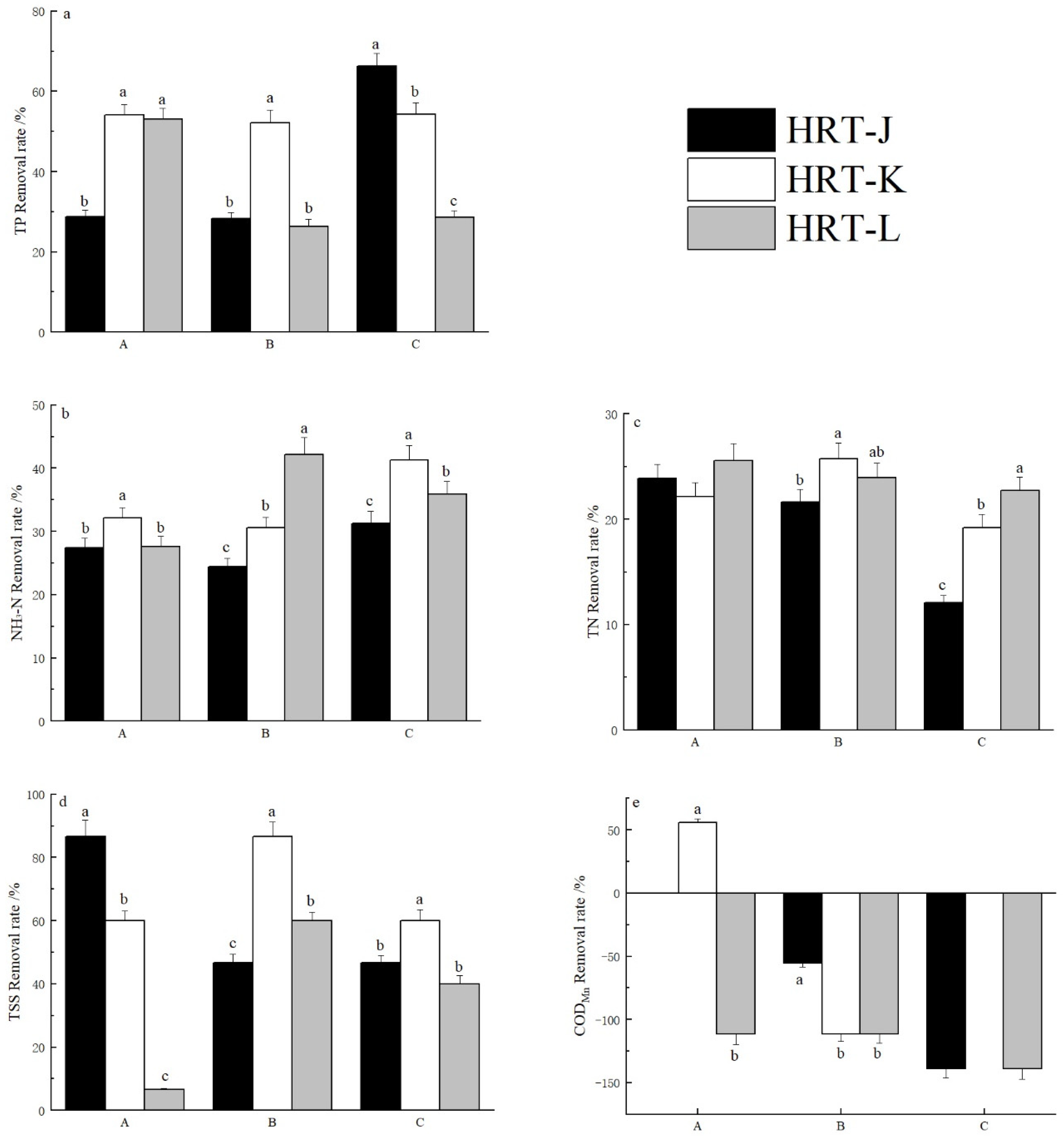
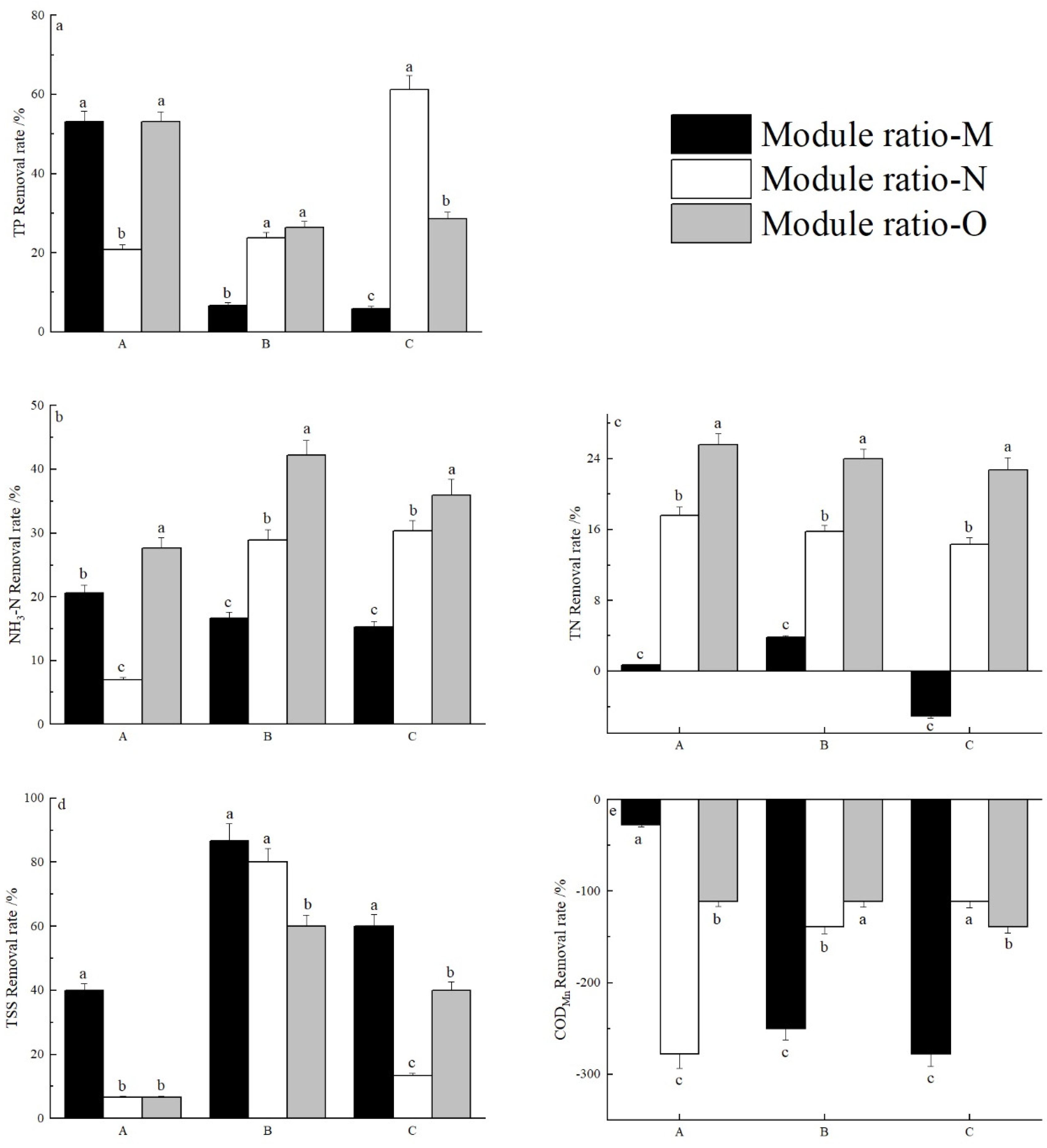
Publisher’s Note: MDPI stays neutral with regard to jurisdictional claims in published maps and institutional affiliations. |
© 2022 by the authors. Licensee MDPI, Basel, Switzerland. This article is an open access article distributed under the terms and conditions of the Creative Commons Attribution (CC BY) license (https://creativecommons.org/licenses/by/4.0/).
Share and Cite
Yin, T.; Zheng, Y.; Liu, T.; Wang, X.; Gao, J.; Nie, Z.; Song, L.; Xu, G.; Yuan, J. Study on Water Purification Effect and Operation Parameters of Various Units of Wastewater Circulation. Water 2022, 14, 1743. https://doi.org/10.3390/w14111743
Yin T, Zheng Y, Liu T, Wang X, Gao J, Nie Z, Song L, Xu G, Yuan J. Study on Water Purification Effect and Operation Parameters of Various Units of Wastewater Circulation. Water. 2022; 14(11):1743. https://doi.org/10.3390/w14111743
Chicago/Turabian StyleYin, Tongtong, Yao Zheng, Tingyan Liu, Xiaofei Wang, Jiancao Gao, Zhijuan Nie, Lili Song, Gangchun Xu, and Julin Yuan. 2022. "Study on Water Purification Effect and Operation Parameters of Various Units of Wastewater Circulation" Water 14, no. 11: 1743. https://doi.org/10.3390/w14111743
APA StyleYin, T., Zheng, Y., Liu, T., Wang, X., Gao, J., Nie, Z., Song, L., Xu, G., & Yuan, J. (2022). Study on Water Purification Effect and Operation Parameters of Various Units of Wastewater Circulation. Water, 14(11), 1743. https://doi.org/10.3390/w14111743





